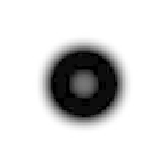Biomedical Engineering Reference
In-Depth Information
(a) Ideal
(b) PVE
(c) RL
(d) BD
FIGURE 7.13: Results of different deconvolution techniques on a 2D artifi-
cial example without noise. (a) A high-contrast sphere on uniform background.
(b) Impact of the PVE, simulated by convolution with a Gaussian kernel. (c)
and (d) PVC results of deconvolution using Richardson{Lucy and blind de-
convolution, respectively.
solution. The iteration scheme is given by
I
0
= C, with C > 0 a constant, uniform image
(7.31)
I
u
P ? I
j
P
T
?
I
j+1
= I
j
·
:
(7.32)
Division and multiplication operations in this iteration scheme are component-
wise. Further technical details can be found in [10]. The RL algorithm is a
special case of expectation maximization algorithms. It is quite popular since
no assumptions regarding amount or type of noise have to be made. Moreover,
no regularization parameter has to be estimated.
A qualitative comparison of van-Cittert deconvolution and Richardson{
Lucy algorithm for PET imaging revealed that the latter performs better
with regard to noise amplification [6].
Blind deconvolution
For an unknown point spread function the previously described methods are
not applicable. Approaches to estimate the PSF are known as blind decon-
volution (BD) methods. The PSF can be estimated either iteratively or in
a single step by using additional knowledge, e.g., anatomical information. In
the next step the estimated PSF is used to perform the deconvolution using
approaches like the Richardson{Lucy algorithm or the Wiener lter [21].
Since the mathematical theory of BD techniques is complex, no detailed
discussion is given here. A BD algorithm for brain-SPECT is discussed in [42].
Figure 7.14 shows the results of different deconvolution techniques for real
PET data. The original image in Figure 7.14(a) shows a liver tumor (dark
structure). In contrast to the artificial example in Figure 7.13 the results of
deconvolution suffer from noise.












Search WWH ::

Custom Search